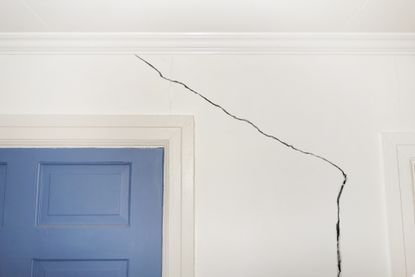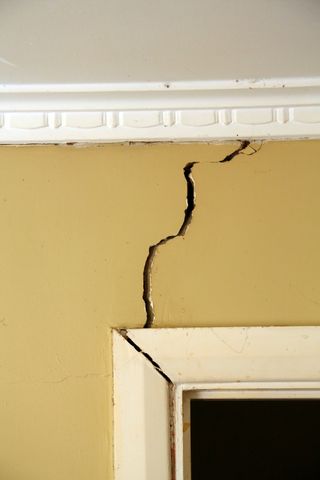What causes cracks in walls – 13 reasons and when you need to worry
Discover what causes cracks in walls and whether they are a cause for concern


Wondering what causes cracks in walls? Well, there are lots of possible causes for cracks in walls – some are simply aesthetic problems that can be easily fixed, but some could be symptomatic of a more serious underlying problem. Therefore, it is important to know what causes cracks in walls and whether you should be concerned.
The answer to the question 'What causes cracks in walls' is very similar to 'Why is my ceiling cracking?' – simply put, the answer is that something has moved. This could be as minor as plaster drying or the walls expanding and shrinking in response to the weather. At the same time, cracks could equally signify a more major structural problem. 'Out of control trees and shrubs, cracked drains, leaking rainwater goods and missing roof tiles; are just some of the things that cause cracks in walls and ceilings,' says Roger Hunt, author of Old House Handbook. If you are unsure of the specific cause of the cracks in your walls, then always consult a professional to guide you as to the best next steps for your specific situation.
What causes cracks in walls: common causes
A new crack in a wall is always a bit scary. 'Before worrying, look for indications that may suggest it is benign. For example, if cracks have been repointed but have not opened up again, it is an indication that movement has ceased. In some cases, despite doors, windows or floors being at odd angles, they have settled into their new position. Providing there is no sign of fresh movement then the problem has likely stabilized,' says Roger Hunt.

1. Your home is new
If your home is a new build, cracks may appear as the buildings settles into its foundations. These cracks will be very fine and will not grow over time. Simply patch up with spackling paste and repaint. Once filled the cracks should not reappear, if they do, then consult a structural engineer.
2. Your home is old
Older homes will move over time. 'Traditional buildings were constructed using lime and other materials, which allow for some shifting of the structure,' explains Roger Hunt.
While this is not an immediate cause to worry, you should never write of a crack because your home is old – they should always be explored incase there has been a structural failure or in case the crack has been caused by damp.
'Cracking in old homes is more likely to occur where hard, modern plasters, cement renders and mortars have been applied to flexible old walls, but superficial cracks up to about 1/32 inch wide are unlikely to be of any great concern,' explains Ian Rock, chartered surveyor and the author of several popular Haynes House Manuals.
However, any cracks that are larger than 1/32 inch this should be investigated more thoroughly, especially if they start at ground level and appear wider at the top. These could be the result of more significant structural movements.
3. Plaster shrinkage
Plaster shrinkage is one of the most common causes of cracks in walls and is the result of moisture loss as the plaster dries and sets. Plaster shrinkage is not a cause for concern and can be spot repaired – learn how to repair a plaster ceiling and no-one will ever know that it used to be cracked – (the same technique works on walls too!).
You can reduce the amount of cracks in your plaster by reducing its drying time, this can be achieved by keeping the room dark and free from breezes. You can also wet the wall before plastering. If it's your first time plastering, be sure to research how to plaster a ceiling as well as the walls to help to achieve a flawless finish first time around.
4. Damp and moisture ingress
As well as causing the signature dark marks on walls and ceilings, damp can also cause cracking. Usually these two symptoms will appear together and should be investigated, especially if they have occurred after heavy rain or flooding. 'Cracks and loose plaster can arise from damp caused by structural issues, and should be repaired with appropriate materials,' says Roger Hunt.
Untreated cracks, especially on exterior walls, can also be a cause of damp problems further down the line, which in turn will cause more cracks. 'Cementitious mortars tend to be of low permeability and are brittle, allowing rainwater penetration via hairline cracks. Repointing may be required using a suitable lime mortar or, in a more extreme case, the application of a lime render or other protective finish may be needed,' explains Douglas Kent.
Once you've identified that the problem is caused by water ingress and fixed a ceiling leak, then you will need to return your walls and ceilings to their previous splendor – knowing how to fix a ceiling with water damage will go a long way to help.
5. Ceiling cracks
Ceiling cracks should always be investigated, as the consequences of not doing so have the potential to be severe.
'Problems with ceilings frequently result from the plaster bond having failed, structural movement, failure of joists, damp problems and rotten or beetle infested laths,' explains Roger Hunt.
'Investigate from above if access is available from a loft or by carefully lifting floorboards and then resolve any structural issues to joists. Always use screws for any fixings to avoid vibrations to fragile ceilings. Where the bond with laths has failed, reinforce by pouring fresh plaster from above and strengthening with a jute scrim set into this and secured to the joists,' he continues.
If you have confirmed that your ceiling cracks are simply the result of plaster shrinkage, then you'll need to learn how to fix ceiling cracks to achieve a flawless finish without depending on costly professional help. Alternatively, knowing how to patch a drywall ceiling may be necessary if this is part of the ceiling structure.
6. Tree roots
Tree roots are a common cause of cracks in homes. As the trees grow the roots expand outwards and often venture underneath houses which can cause subsidence. 'Some of the worst offending trees are broadleaf species such as poplars, oaks, willows, ash, plane and sycamore trees, as well as fast-growing leylandii and eucalyptus. But trees can also be an indirect cause of subsidence where moisture-seeking roots invade underground drains causing them to leak,' says Ian Rock.
If this is the case, then it might seem like the best solution is to remove the offending trees. However, this can cause more harm than good. 'The problem with cutting down large, thirsty trees is that the ground may then swell with the moisture that’s no longer being absorbed by the tree, with the risk that it can then push the foundations upwards,' adds Ian. 'Known as ‘heave’, this is the opposite of subsidence.'
Instead, the best approach is 'tree management', which aims to 'pollard' the tree to reduce its amount of moisture uptake. '‘Root barriers’ are an alternative method of tree management which involves excavating a deep, narrow trench between the tree and the building into which special large rigid plastic sheets are inserted. This offers the advantage of retaining attractive trees whilst protecting the foundations,' explains Ian.
7. Earthquakes and vibrations
Any violent movement to a house can cause cracks – the most common being earthquakes. If you notice any cracks after an earthquake it is best to get them investigated in case they are a symptom of more severe structural damage.
8. Subsidence
The word 'subsidence' is every home owners worst nightmare and will be the main concern when cracks start appearing in your home.
'Subsidence refers to the ground beneath foundations giving way, robbing the wall of support and causing it to drop, cracking in a typical ‘V’ shaped pattern. So why does ‘ground collapse’ happen? The effects of droughts, tree roots and heavy frosts can cause clay subsoils to violently shrink or swell, and leaking drains can turn the ground under your house into soft, squelchy marshland. Nearby excavation work, such as an extension being built next door can also be a destabilising influence. Fortunately, subsiding ground due to sinkholes and old mine workings is extremely rare,' says Ian Rock.
9. Settlement
Any changes to the weight of your house can cause movement. For example when walls have been moved or removed or windows have been replaced, cracks may appear as the masonry settles into its new position. Unlike cracks caused by subsidence these cracks will not continue to grow over time and once settled can be filled in.
'Settlement commonly gets mistaken for subsidence, however, unlike subsidence this is not usually a serious concern because most buildings gradually settle over time as the ground is slowly compressed adjusting to new weights imposed upon it, for example, from major structural changes like a loft conversion,' explains Ian Rock.
10. Differential movement
'Where you have different foundation depths adjoining each other, such as an old house with a modern extension, cracking can occur at the junction between the two structures due to different rates of movement. One way to accommodate this is to provide a flexible joint between the two parts of the building, allowing them to move harmlessly against each other without cracking. But differential movement is nothing new – similar problems can periodically arise where Victorian bay windows were built with shallower foundations than those to the main house,' says Ian Rock.
11. Climbing plants
We all love the beautiful effect of growing the best climbing plants up the front of the house – however, if you have climbing plants trained up the exterior walls of your property, then you should always be cautious of any new cracks appearing in the exterior or interior wall.
'Climbing plants should be carefully monitored. Ivy in particular will destabilize walls as its roots find their way into cracks and crevices, especially where pointing is defective, and as the tendrils grow and expand they force the masonry apart,' says Roger Hunt. 'If they start to cause a problem, established plants should be cut off near the root and poisoned. Then, once the foliage has died back, it can carefully be removed.'
If you want the effect of growing the best flowering climbers up the front of your house, why not train them up one of these trellis ideas to reduce the likelihood of them causing cracks. You can also grow them in a pot to reduce the effect of the roots on the ground underneath your home.
12. Neighboring renovation projects
If you live in a terrace house, cracks over ¼ inches on your adjoining wall should always be a cause for concern.
'It’s not unknown for neighbours to carry out illegal basement conversions, undermining party walls and causing dangerous structural cracking in adjoining houses,' explains Ian Rock. This can also be caused by neighbors excavating the ground to build an extension.

Types of cracks:
What causes horizontal cracks?
Large horizontal cracks are usually caused by structural movements and as such should be treated seriously as they are often a result of severe foundation shifting or water damage. Always ensure these cracks are investigated by a professional.
What causes diagonal cracks in walls?
Diagonal cracks in walls are usually caused by structural deterioration. This could be the result of by subsidence, termite damage or the collapse of supporting wood timbers. Diagonal or jagged cracks are one of the most concerning and should always be checked by a professional.
What causes vertical cracks
Vertical cracks are usefully found at the point when the wall meets the ceiling and are often the result of settlement. These cracks, unless they are growing length or width-wise are usually nothing to be concerned about. However, if there is water ingress, signs of damp or the crack appears to be life, it is worth getting investigated to be on the safe side. Also get them assessed if the crack is greater than ¼ inch wide.
How do you tell if a crack in a wall is serious?
You can tell if a crack in a wall is serious because it will be more than ¼ inch wide and will grow over time.
A singular hairline cracks on interior walls shouldn't be a cause for concern. You can simply fill with spackling paste, allow to dry and then repaint. However, if there are several around a central point, it will need further exploration. The same applies if the crack continues to grow over a short period of time. If a crack is more than ¼ inch wide, 'you should consult a structural engineer as the foundation could become weak and might even lead to a collapse,' recommends trade experts at MyJobQuote.
'Monitor the problem over time to establish its extent and to determine whether the movement is ‘live’. Put a pencil mark at the point where the crack ends, date it and repeat the process on a regular basis if the crack continues to grow. Check whether the crack opens and closes with the seasons,' says Roger Hunt. It can take over a year to assess whether a crack is 'live'.
Any cracks that are on an exterior wall should always be investigated as it may be a sign of structural issues. They can also be an entry point for water which will cause damp problems further down the line.
Sign up to the Homes & Gardens newsletter
Decor Ideas. Project Inspiration. Expert Advice. Delivered to your inbox.

Having graduated with a first class degree in English Literature, Holly started her career as a features writer and sub-editor at Period Living magazine, Homes & Gardens' sister title. Working on Period Living brought with it insight into the complexities of owning and caring for period homes, from interior decorating through to choosing the right windows and the challenges of extending. This has led to a passion for traditional interiors, particularly the country-look. Writing for the Homes & Gardens website as a content editor, alongside regular features for Period Living and Country Homes & Interiors magazines, has enabled her to broaden her writing to incorporate her interests in gardening, wildlife and nature.
-
 The best Shark vacuum deals 2024: cordless, upright and robot vacuums on offer now
The best Shark vacuum deals 2024: cordless, upright and robot vacuums on offer nowBrowse all the best Shark vacuums deals, whether you're looking for an affordable cordless, upright or robot vacuum.
By Dan Fauzi Published
-
 If you're new to freshly ground coffee, you'll need the Barista & Co Core All Grind Plus Grinder
If you're new to freshly ground coffee, you'll need the Barista & Co Core All Grind Plus GrinderOur qualified barista tested Barista & Co's Core All Grind Plus coffee grinder across a range of settings, including its auto-dosing function
By Laura Honey Published
-
 7 dorm room organizing rules for less clutter and more space
7 dorm room organizing rules for less clutter and more spaceExperts offer their top tips for creating a well-organized dorm room, no matter the size, space, or layout.
By Ashley Chalmers Published
-
 How to maximize storage in a small or shared dorm room, according to pro organizers
How to maximize storage in a small or shared dorm room, according to pro organizersFind out all the hidden storage zones you might never have noticed
By Ashley Chalmers Published